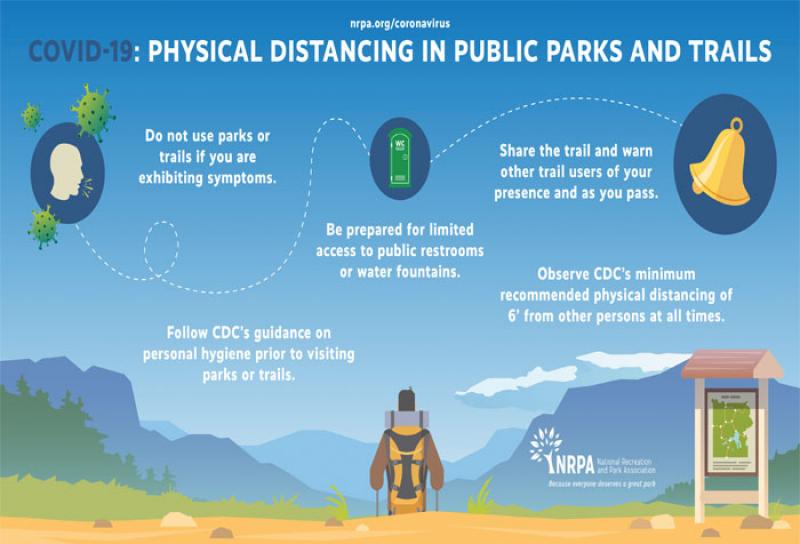
Expert Q&A: RST's Kim Shinew on trails and COVID-19
The College of Applied Health Sciences has experts in many areas that have been affected by the COVID-19 outbreak. Periodically we will ask these experts about how their areas of expertise have been impacted and what we can expect in a post-COVID-19 world. Today, we ask Kimberly Shinew, a professor in the Department of Recreation, Sport and Tourism, about her research about exercising on trails during the current COVID-19 crisis.
Q: Are you finding that people are obeying social distancing guidelines on trails?
A: It has been mixed. Although the analysis has not been run, my estimation would be about 50 percent make an effort to social distance. I am doing observations at a trail in Champaign. My colleagues are doing observations at trails in Colorado, Texas, Florida, Minnesota and California. When people meet along the trail, typically no effort is made to move off the trail to allow for the recommended six feet. That said, it is also common to see one party move so as to avoid getting too close to the other party.
Something many of us have noticed is that it is difficult for people to maintain social distancing while on the trail. For example, most people arrive at the trails with others, and it is clear that those groups are not trying to maintain social distancing (e.g., with family members). However, other times you will see people meet up at the trail, and may even comment about making sure they maintain social distancing. However, after a lap or two, the distance narrows and they walk as we normally would around the trail.
Q: What steps should organizations take to ensure that people obey the guidelines?
A: Many agencies, including the Champaign Park District, have encouraged safe use of the trails and parks. There are now signs along the trail that read:
- Remember Stay Home if Sick
- Maintain Six Feet Between Yourself and Others
- Wear Face Masks in Public (as Recommended by CDC)
Some of the other sites across the country have gone to one-way routes. Although this can be helpful, it causes people passing others and this also creates distancing problems.
The National Recreation and Park Association have offered guidelines for trail users on observing physical distancing minimums. For example, some of their recommendations include:
- Follow CDC’s guidance on personal hygiene prior to heading to trails—wash hands, carry hand sanitizer, do not use trails if you have symptoms, cover your mouth and nose when coughing or sneezing, etc.
- Observe at all times the CDC’s minimum recommended physical distancing of six feet from other people. Practice it and know what it looks like. Keep it as you walk, bike or hike.
- Warn other trail users of your presence and as you pass to allow proper distance and step off trails to allow others to pass, keeping minimum recommended distances at all times.
- Signal your presence with your voice, bell or horn.
Additionally, I have noticed an increase in people wearing masks on the trail. This increase coincided with the CDC recommendation. In the beginning of the data collection process, I rarely saw people with masks on the trail. Now, it would be rare for me NOT see people with masks. It is certainly not the majority of people, but there are always a couple of people.
Q: Do you believe COVID-19 will force trails to be redrawn or reimagined to allow for future social distancing guidelines?
A: Honestly, I doubt it. In many cases this would be cost prohibitive. However, I do think that for many of us, our desire to maintain social distancing while in public will continue for quite some time. How long depends, in part, on factors such as availability of testing, effectiveness of contact tracing, quarantine procedures, and possible treatments.
Q: Do you believe this outbreak has forced people to think differently about the importance of trails?
A: Yes, evidence indicates the outbreak has had an impact on attitudes about trails. Several sources have indicated a surge of public use of trails and open outdoor areas of parks over the last month. Many park and recreation agencies have closed facilities, canceled programs, removed nets from tennis courts and basketball courts, and closed playgrounds. However, many agencies have not closed parks and trails. With so many other physical activities being eliminated, people are walking, biking, and jogging so trails are getting more use.
I also think people are appreciating being outdoors. Many of us are spending much more time in our homes due to sheltering-in-place orders. Having an opportunity to get outside (and out of the house) seems to be a welcome distraction right now. Additionally, the weather is improving and that is increasing people’s motivations to be outdoors.
Q: What’s the goal of your observational study, and what is the next step?
A: We started this study quite early, at the beginning stages of the pandemic. We have been collecting data for several weeks and have already noticed quite a few changes (masks and additional signage) just since the start of the project. For example, when I first began my observations the playgrounds were still open. Our plan is to continue to collect data to see what other trends we might observe. With many park and recreation agencies indicating that swimming pools and other facilities and programs will be closed (or will have a delayed opening date) this summer, we anticipate that trails may continue to get increased use in the coming months. Also, once we are feel it is safe, we would like to conduct interviews with the trail users to gain insights into their experiences on the trail.
